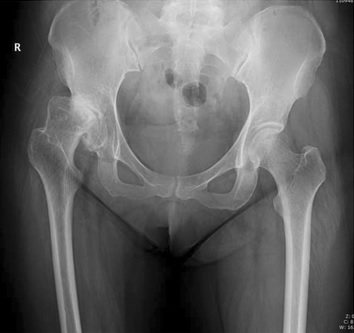Article reviewed and approved by Dr. Ibtissama Boukas, physician specializing in family medicine
hip dysplasia corresponds to a malposition of the hip joint. It causes functional discomfort and pain at this level. It is usually hereditary and affects one in 1000 babies at birth. This anomaly is often observed in infants and young children, but it is possible that it does not appear until adulthood. It is more common in women than in men.
What is hip dysplasia? What are the causes ? How does it manifest? And how to treat it? We will answer these questions in this article.
Definition of hip dysplasia
hip dysplasia is a congenital malformation characterized by deformation of the coxo-femoral joint. Indeed, the hip joint is formed by the interlocking of the femoral head and the articular cavity of the pelvis or the acetabulum (acetabulum). Both surfaces are covered with cartilage. The latter acts as a shock absorber between the two bones and facilitates the sliding of the femoral head in the acetabulum. When the acetabulum does not sufficiently cover the femoral head, we speak of hip dysplasia.
This pathology generates a slight laxity of the articular cavity of the hip. But, it can also cause a total dislocation of the joint. Sometimes it causes dislocation, pain or even disability.
Note: To learn all about hip dysplasia in babies, see the following article.
The probable causes of this joint pathology of the hip
Malposition of the hip joint can be inherited or acquired. The main causes of dysplasia in adults are related to different factors from birth.
Generally speaking, this pathology results from the breech position of the baby in the uterus. In this position, the baby's hip is in a flexed position while his knees are in extension at the time of delivery.
Insufficient amniotic fluid or an undersized uterus in the mother also increases the risk of this hip disease in the child.
In some cases, it is a fetal reaction to maternal estrogen. It turns out that this causes the hip ligaments to loosen and thus the femoral head to slip out of the acetabulum.
Other factors can also cause dysplasia, namely:
- twin pregnancies;
- multiple pregnancies;
- the intrauterine position of the baby…
In this disease, the femoral head does not fit exactly with the acetabulum (articular bone cavity). In this case, it is decentered and comes out of its housing. Later, the acetabulum is damaged. The cartilaginous cavity, on the other hand, ossifies and causes the malformation.
La reason for hip dysplasia in adults is probably related to the fact that it may initially be asymptomatic or with uncharacteristic symptoms. Thus, no screening or treatment of the pathology could be carried out during childhood.
Symptoms of hip dysplasia
In the majority of cases, this disease occurs on one side only, most often on the left side. This is related to the intrauterine position of the fetus.
Signs of hip dysplasia are difficult to perceive without screening by X-ray and ultrasound. A physical examination may not be conclusive. Nevertheless, the doctor is able to find some characteristic signs of joint pathology.
La search for this pathology is a mandatory process when a baby is born. For this, the doctor uses the Barlow maneuver. It appears to be the most reliable technique for testing newborn hip laxity.
In general, hip dysplasia is manifested by more or less intense hip pain, especially in the fold of the groin, sometimes at the level of the buttocks. The pain may radiate to the knee. It occurs during an activity soliciting the hip as well as walking. She often calms down at rest.
In case of hip dysplasia, inequality in the length of the lower limbs is also a common sign. This is mainly due to the progressive dislocation of the hip.
In addition to its symptoms:
- manifestations of instability such as a limb that fails;
- a slight abnormal sound when opening and closing the legs;
- waddling (abnormal) walking;
- hip displacement;
- an inability to perform certain movements;
- loss of hip mobility;
- difficulty opening the thigh outwards;
- a curvature of the spine.
This anomaly is often responsible for early osteoarthritis of the hip. This can occur before the age of 30.
How to treat this anomaly of the hip joint?
Apart from pain relief, the main objective of hip dysplasia treatment is to position the femoral head in the acetabulum to ensure the proper functioning of the hip.
Le hip dysplasia treatment is prescribed depending on the severity of the disease. In newborns, the treatment is lighter compared to that of an adult. If the treatment is carried out in time, surgery will not be necessary. The treatment can correspond to a modification of sports practices, weight loss or direct rehabilitation of the hip.
If these techniques are not effective, one must go to conservative hip surgery.
In fact, the shape of the hip does not correct itself spontaneously. Anti-inflammatories and pain killers can help relieve pain, but they do not cure the condition. This is when surgery comes in. This intervention aims to better distribute the pressure exerted on the cartilage of the acetabulum and the head of the femur. It also makes it possible to increase the opening of the acetabulum, to reduce the angle of the femoral neck or both at the same time.
This procedure lasts about an hour and a half and requires 7 days of hospitalization. It can be performed under local or general anesthesia. This choice depends on the patient's condition. As a result of the operation, the patient should do a sterile dressing for about 10 days. A treatment to calm the pain will also be put in place. This treatment is adapted and monitored during the postoperative period.
In addition to conservative hip surgery, the orthopedic doctor can sometimes resort to total hip prosthesis. This option will be discussed with the patient if there is significant and incapacitating coxo-femoral osteoarthritis.
What about rehabilitation after treatment?
Rehabilitation after the operation is essential to help you get up and walk. The session can start the day after the intervention. Carrying two canes is very beneficial and recommended to relieve hip pressure from weight for about 6 weeks.
Hip rehabilitation is performed with the help of a physiotherapist. The program aims to:
- soothe the initial pain;
- preserve the flexibility and mobility of the hip;
- accelerate muscle recovery at this level.
Returning to work is possible after 3 months, but it still depends on your profession and your condition.
The beneficial effect of conservative hip surgery is that we find an improvement in pain in more than 90% of cases. You will be able to walk properly, without limping. The hip will regain its natural balance and all types of sporting activity are possible, except activities that put too much strain on the hip. These activities can break down the cartilage again.


